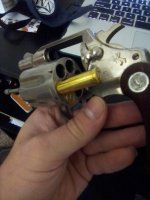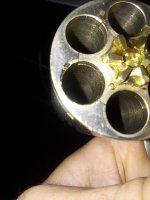Its misleading to call it a scratch. A scratch is generally below the surface,and metal has been removed. You can't really "polish out" a scratch. You can polish the surface the scratch is in away,till you have lowered the surface to the bottom of the scratch. To do that,you change the dimensions and typically the geometric form of what you polish. In other words,yu can polish a chamber to egg shape.
But a scratch is not your problem. A scratch would not impede you inserting a cartridge.
You have a dent. Or,as some have mentioned,a ding. The metal was not removed,it was displaced. And its not compressable. The metal is still there.
Its been pushed down,and it flowed in the direction of least resistance,which is into the chamber. So,you have metal sticking up high,and that interferes with inserting cartridges.
I spent a long time making and repairing steel plastic injection molds. They sometimes get similar damage at the edga of the cavity on the parting line.
I would guess the metal is displaced as much as 1/8 in down the cylinder wall. Hard metal will chip or crack. That metal was mallable enough to displace, to a degree,it can be displaced back where it belongs. I myself would not start with cutting. There are a number of possible approaches.
I might use a drill blank,which is a round,hard piece of high speed steel,ground and polished, or I might order a replacement pin gauge for the pin gauge set,,and "borrow" (ruin) a pin from the set that will just slip through the chamber past the ding. Pin gauge filling the entire chamber,not part way in,I'd tap,tap,tap the pin with a little hammer ,on the side of the pin opposite the ding. You are using the pin as a form to forge the metal back into place, Now,don;t make a low spot! Reduce the high spot, If you can reduce it 70% or 90%,its all good! Don't educe it 105%
Toward the finish of the project,a little burnishing action may help.
When that was close enough,I'd use a fine round India stone to gently "float: the high spots off.For a final finish, I might run a drill and tap into the primer pocket of a piece of ,38 or ,357 brass,thread some form of handle into it,and use it for a lap with some 600 grit aluminum oxide lapping compound.
Just stroke a bit ,always to float off high spots without making low spotsCareful not to bellmouth the chamber. A swab of cold blue will give you contrast to see what you are doing.
Thats probably what I would do, but again,I have experience doing such things.Molds,revolvers...its all a piece of steel.


